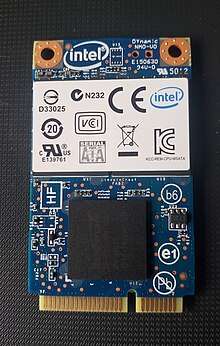 A 2.5-inch Serial ATA solid-state drive | |
| Usage of flash memory | |
|---|---|
| Introduced by: | SanDisk |
| Introduction date: | 1991 |
| Capacity: | 20 MB (2.5-in form factor) |
| Original concept | |
| By: | Storage Technology Corporation |
| Conceived: | 1978 |
| Capacity: | 45 MB |
| As of 2024[update] | |
| Capacity: | Up to 200 TB[citation needed] |


A solid-state drive (SSD) is a type of solid-state storage device that uses integrated circuits to store data persistently. It is sometimes called semiconductor storage device, solid-state device, and solid-state disk.[1][2]
SSDs rely on non-volatile memory, typically NAND flash, to store data in memory cells. The performance and endurance of SSDs vary depending on the number of bits stored per cell, ranging from high-performing single-level cells (SLC) to more affordable but slower quad-level cells (QLC). In addition to flash-based SSDs, other technologies such as 3D XPoint offer faster speeds and higher endurance through different data storage mechanisms.
Unlike traditional hard disk drives (HDDs), SSDs have no moving parts, allowing them to deliver faster data access speeds, reduced latency, increased resistance to physical shock, lower power consumption, and silent operation.
Often interfaced to a system in the same way as HDDs, SSDs are used in a variety of devices, including personal computers, enterprise servers, and mobile devices. However, SSDs are generally more expensive on a per-gigabyte basis and have a finite number of write cycles, which can lead to data loss over time. Despite these limitations, SSDs are increasingly replacing HDDs, especially in performance-critical applications and as primary storage in many consumer devices.
SSDs come in various form factors and interface types, including SATA, PCIe, and NVMe, each offering different levels of performance. Hybrid storage solutions, such as solid-state hybrid drives (SSHDs), combine SSD and HDD technologies to offer improved performance at a lower cost than pure SSDs.
- ^ Whittaker, Zack. "Solid-State Disk Prices Falling, Still More Costly than Hard Disks". Between the Lines. ZDNet. Archived from the original on 2 December 2012. Retrieved 14 December 2012.
- ^ "SSD Power Savings Render Significant Reduction to TCO" (PDF). STEC. Archived from the original (PDF) on 2010-07-04. Retrieved October 25, 2010.